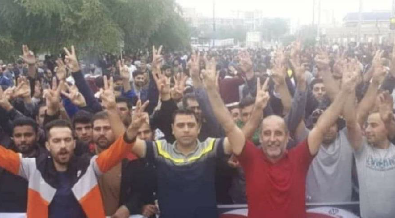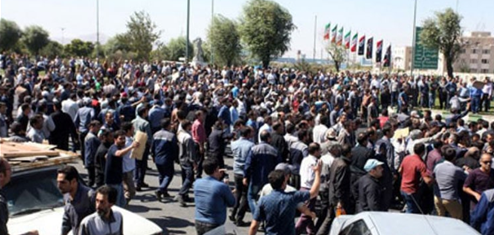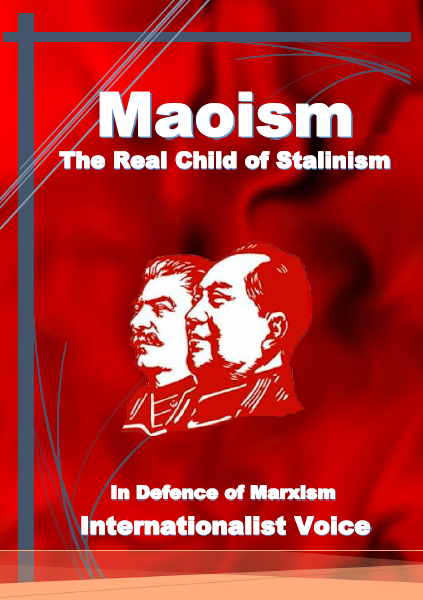The continuation of the social protests and the entry of the working class into the demonstrations
There are no supreme saviors
Neither God, nor Caesar, nor tribune.
Producers, let us save ourselves[1]
The street protests that started at the end of September quickly expanded to universities. The suppression of the Sharif University of Technology protests could not stop the spread. On 8 October 2022, when the executioner Raisi (the president) visited Al-Zahra University to mark the new academic year, the students greeted him with the slogan “Death to the oppressor, whether he is the king or the supreme leader!” Raisi also called the protesters flies.
The university has historically been a place of gathering and protest, but with the suppression of the universities in 1980, the Islamic bourgeoisie essentially exercised its sovereignty over them, and after that student protests took the form of bourgeois factional conflict. Although the university became a centre of protest again in 2007, this was soon suppressed, and since then the student protests have been weak. But during the recent ones, universities again became a site for assembly and demonstration, and more importantly, the student movements spread to high schools.
In all class societies, in addition to class oppression, sexual oppression is also applied to women, especially those of the working class. Due to its ideological superstructure, the Islamic bourgeoisie has given this oppression a monstrous and medieval form. Throughout this history, women have been an integral part of the protest against social inequalities. Contrary to the rotten and backward culture of the Islamic bourgeoisie, women have played an active role in struggles, in both strikes and street protests. During the protests and uprisings of 1978-1980, women, in the literal sense of the word, participated alongside men. Women’s struggles to defend their social and human conditions also began with the rise of the Islamic bourgeoisie. Despite all this, we should not forget that humans live in a class society and belong to a certain social class. The main root of the oppression of women is not in the ideological superstructure of the Islamic bourgeoisie, but in the class system, as well as capitalist production relations. To fight against the sexual oppression of women, we must challenge the root of this oppression, which is capitalist social relations. With the rise of social struggles, young women and girls have participated in the conflict with more enthusiasm. But it must be emphasized that, contrary to democratic illusions, women will not be freed from the yoke and shackles of capitalism, unless working women together with working men, as members of a social class, advance their independent struggle with class goals and avoid becoming the black army of the democracy movement.
Apart from the class composition of the participating forces, the nature of a social movement is determined by its demands and goals. It is in such a context that the slogans used become very important and determine the direction of a protest. The phrase “woman, life, freedom” is rooted in the national movement and has no class burden. This is why this slogan is raised from the far right to the far left, and its echoes can be heard from the bourgeois parliaments. Its components are not abstract concepts, but a function of capitalist production relations. Such a slogan makes working women the black army of the democracy movement. This issue becomes a problem for the left of capital, which employs the radical term “revolution,” so they suggest that this slogan should be “saved” by adding extensions. They have made the following suggestions:
- Woman, life, freedom, council administration (Trotskyists)
- Woman, life, freedom, socialism
- Woman, life, freedom, workers’ government
Contrary to those on the left of capital, the task of communists and revolutionaries is not to save anti-dictatorship slogans, but to provide transparency regarding their origin and content. Again, in opposition to the demagogues on the left of capital, distancing themselves from such slogans and raising the class demands of the proletariat is a step in the direction of refining the class struggle.
The undeniable fact is that the regime will not fall because of street, student and other social strata protests, and the dirty Islamic bourgeoisie can continue its shameful life with unbridled repression. Only the entry of the working class as a social class will change the equation. On 8 September 1978, the Imperial Army of Iran crushed the anti-royalty demonstrations in Jaleh Square and caused a bloodbath, which became known as Black Friday. After Black Friday, the Shah continued to rule. It was only as labour strikes and protests spread to the oil industry and oil exports were cut off as a result that the Shah felt threatened. The global bourgeoisie also realized that it would be better to change the superstructure of the political system in order to prevent labour protests from becoming radicalized. America, England, Germany and France organized the “Guadeloupe” conference, where they came to the conclusion that the Shah should leave and Khomeini would be a suitable alternative to the Shah’s regime. The same danger exists today even more so than then. The Westerners, especially America, have declared their support for the protests because of their imperialist interests, but the indisputable fact is that the Western bourgeoisie is worried about the radicalization of social protests and that they may get out of control and lose the initiative for future alternatives.
It is in this context that bourgeois institutions and especially Western journalism play the greatest role in engineering public opinion. The New York Times has highlighted an ex-/pro-regime journalist who has now changed direction and is building an alternative movement with the help of Western institutions, and this mercenary (Masih Alinejad) claims that “I’m leading this movement.”[2] The “honourable” British journalists of the Telegraph newspaper create heroes with headlines such as “Iran’s Revolutionary Guards seek arrest of “Asian Maradona” over support for protests.”[3] Colourful celebrities from Kim Kardashian to Justin Bieber and other stars talk about Mehsa Amini’s horrible death.[4] And their statements are best reflected in the media. On 25 September 2022, the French newspaper Liberation decorated its front page with the slogan “Women, Life, Freedom” in Persian and French along with a photo of the demonstration. During a speech about the repression of protesters in Iran, a member of the European Union Parliament cut her hair while saying the words “Woman, Life, Freedom” on the floor of the European Union Parliament.[5] This list can be extended. But the statements of Robert Malley, the US special representative for Iran, are worthy of reflection and better depict the positions of the West. He said:
“It’s not a policy of regime change. It’s a policy of backing.”[6]
The Western bourgeoisie pursues two goals in condemning the Islamic bourgeoisie and supporting the protests. The first is to put pressure on the Islamic bourgeoisie and weaken it, so that, as a weak and obedient regime, it will accept the Joint Comprehensive Plan of Action (JCPOA), give up its imperialist ambitions in the region, and assist with the energy crisis of the West in the current critical situation, so that the West is better able to put economic pressure on Russia. The second aim is to prepare an alternative for a rainy day to replace the Islamic bourgeoisie. If the need to arrange a shift in political power takes place, the Western bourgeoisie can present its alternative, as in 1979. The large demonstrations of 1 October 2022 that occurred all over the world, which were characterized by national solidarity and the Iranian flag, and were completely dominated by the bourgeois right opposition, although it was supported by the left and had the broad backing of Western bourgeois institutions, were part of the second goal of the Western bourgeoisie. It is not inappropriate that Western journalism played an important role in focusing attention on these demonstrations with all possible means, and the same procedure is still being followed. The important point is that the demonstrators within Iran have never carried the Iranian flag and their slogans have been much more progressive than those of the 1 October demonstrations.
From the right wing of capital to the left, they know and remember in their historical memory that history has shown that it is not possible to overthrow the Islamic bourgeoisie without the participation of workers in social protests. And, therefore, they ask the workers to come to the square and finish the job. In other words, they want the working class to become the black army of the anti-dictatorship campaign so that the change in the political superstructure of the society is not only possible but also accomplished sooner.
On 10 October 2022, the workers of Bushehr and Damavand Asalouye petrochemicals and the Abadan and Kangan refineries joined the protest and strike. Workers with the slogan “Death to the dictator!” entered the scene of protests. Although this was not a class slogan but an anti-dictatorship one, is an absolute necessity for the class struggle that workers come out to fight. But it must be emphasized that our slogan must be against wage slavery and exploitation, and in other words, must target the foundations of capitalism. We must fight for our own class interests. We must never lose our class identity or our revolutionary abilities in shaping ourselves as an independent social force in the evolution of society through class struggle. Only the working class as a social class can end the misery of the capitalist world. We can only repel the attacks of the bourgeoisie from our own class ground. The working class should not be dragged into the pro-democracy movement, and worse than that, becoming the black army of the pro-democracy movement would weaken and incapacitate the working class.
Due to its special characteristics, the workforce of the oil industry enters protests later, but when it does join labour protests and strikes, it really breaks the back of the bourgeoisie. A clear example is the strikes and protests of Iran’s oil industry in 1979.
The chained workers!
The working class of Iran, as a battalion of the global working class, is the most concentrated and experienced one in the Middle East, and has achieved brilliant battles in its historical memory, especially in the years 1978-1980. The working class must take the initiative for protests in the anti-capitalist struggle and supplement their struggles with street and student protests. In such a situation, street and student protests will be in line with, serve and form a part of the class struggle.
The duty of communists and internationalists is not to follow social events, but to defend the communist programme and the proletarian horizon in protests and social struggles. Communists and revolutionaries should form the compass of class struggle by referring to the historical memory of proletarian battles.
The real power of the working class is not in stopping the accumulation of capital, or in overthrowing dictators, but in appearing to be a social class that is aware of its historical duty. The question concerns what this social class has historically been forced to do, because only this social class is capable of carrying out the global communist revolution.
Long live the war between the classes!
M. Jahangiry
11 October 2022
Notes:
[1] Taken from The International.
[3] The Telegraph
[4] Kim Kardashian, Justin Bieber and more stars speak out on the horrific death of Mahsa Amini in Iran
[5]The Guardian
[6]NPR














